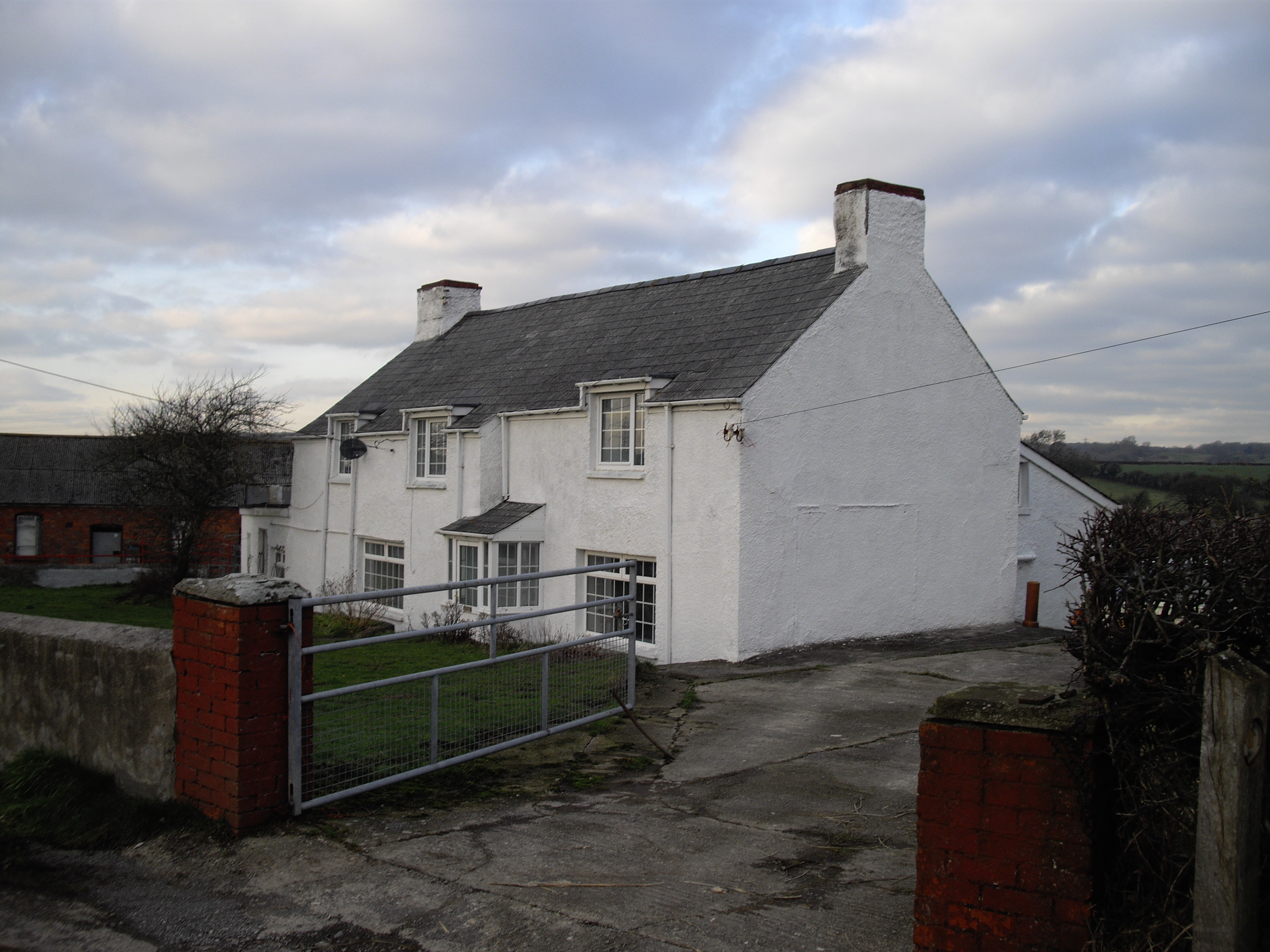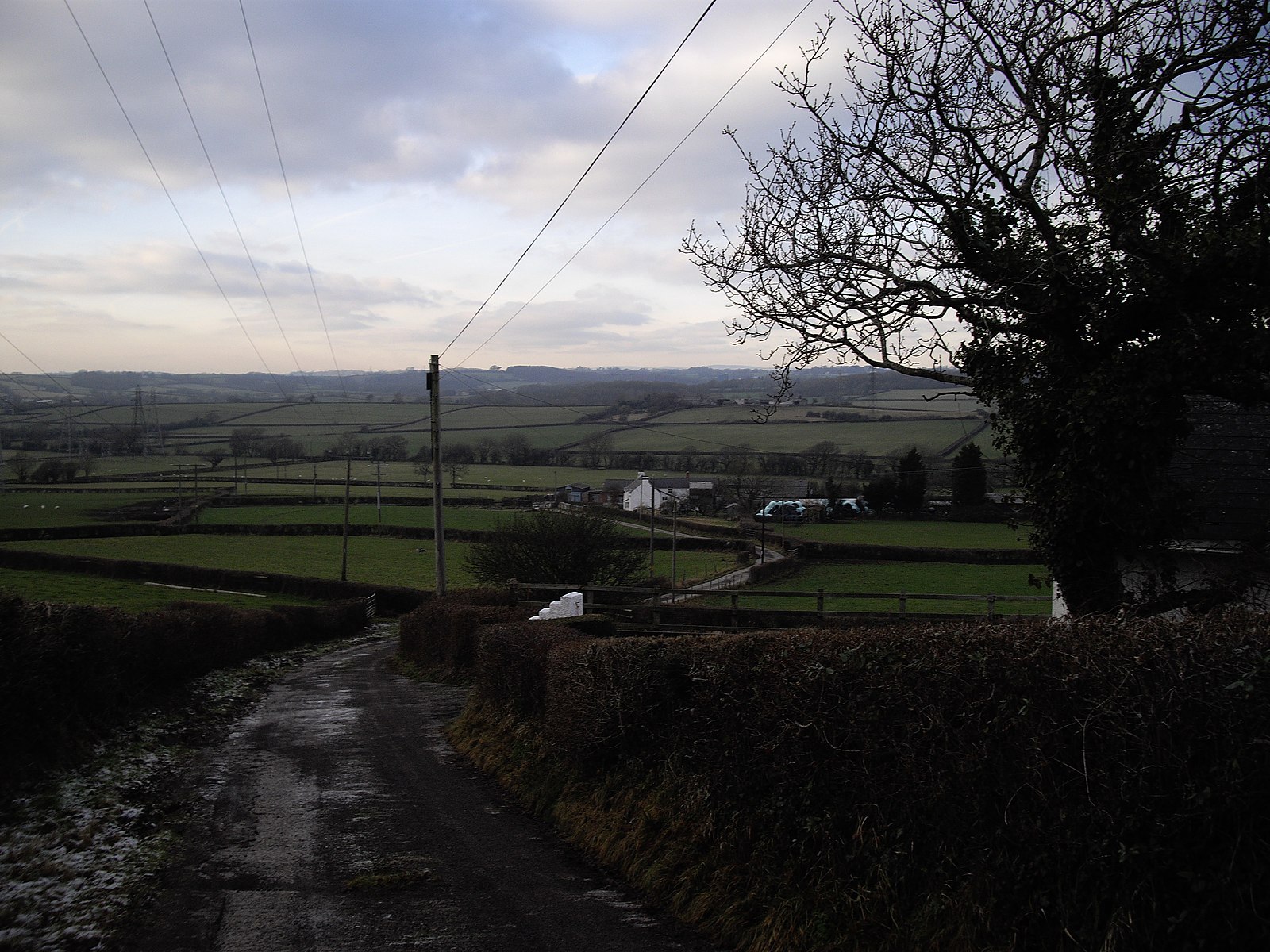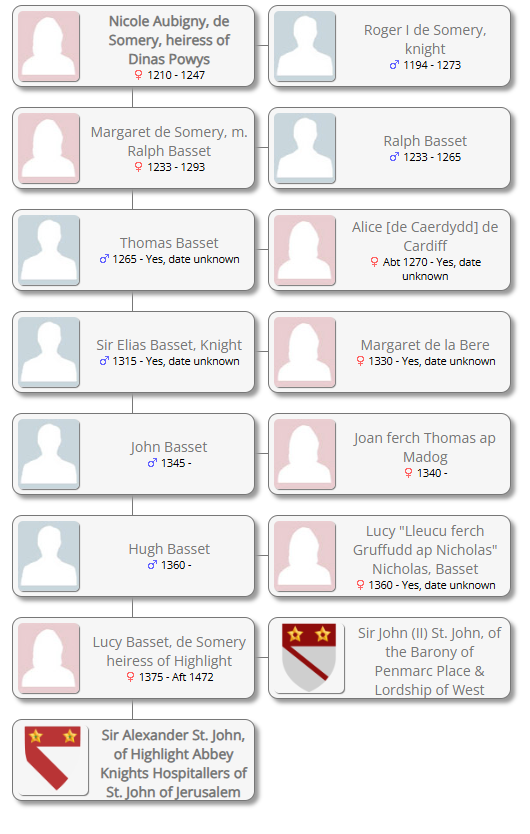
 The St. John Genealogy Project
The St. John Genealogy Project
Origin and Ancestry DNA Database & Electronic Archive
The sign for the Brynhill Golf Club.


Great Brynhill Lane, the larger farm in the distance at the foot of the "Brynhill"

By John Lord, CC BY-SA 2.0, https://commons.wikimedia.org/w/index.php?curid=19147936
Great Brynhill is a small hamlet and farm in the Vale of Glamorgan in south Wales. It consists little more than a few farms including the Little Brynhill Farm and Thorn Falcon Farm (Little Brynhill) and the Great Brynhill Farm. It is located in the historical parish of Merthyr Dyfan and near Colcot now northern districts of the town of Barry. It is accessed via a lane from Port Road (the A4050 road) but can also be accessed from Dyffryn along the lane to the New Wallace Farm and Goldsland which lie just to the northeast. "Bryn" means "hill" in Welsh, so the name literally means "Great hill hill".
The Little Brynhill Farm is owned by the Tanner family who are notable milk suppliers in Barry under the company name "W. A. Tanner & Son". One of the farms sold off some of their land along with neighbouring Highlight Farm when Brynhill Golf Club was formed in 1921. According to the Barry & District News, Thorn Falcon Farm sold for 400,000l on 25 November 2005.
This deserted Medieval village is being extensively excavated and examined by Howard J. Thomas and Gerald Davies on behalf of the Barry and Vale Archaeological Group who began their researches in 1946. The remains of the church are now clearly visible, thanks to their efforts. It was a simple church with nave, chancel and South Porch measuring overal some 45 by 20 feet and probably built about 1200-1250 A.D. with the pourch added some century later. the description of the priest's burial is appended for interest, and for it I am indebted to Mr. Thomas.
In addition to the church the group has uncovered the remains of a priest's house, a possible mill, an old road, and the remains of several other buildings including those of an unrecorded 15th century manor house. In fact it is a complete Medieval village site which, for some unknown reason, was abandoned by the inhabitants.
There are no records of the consecration of the church nor any clues as to its name. Oddly enough even its later history is obscure. Because the village is now claimed as part of the civil and ecclesiastical parish of Wenvoe; yet there is no trace of its having been haded over in the diocesan registers from the parish to Wenvoe, with which it has little physical connection, the main road being wholly in the Parish of Merthyr Dyfan.
By Howard J. Thomas M.A., F.S.A.
The deserted medieval village of Highlight (Uchelolau) was partially excavated by the Barry and Vale Archaeological Group between 1964 and 1969. The settlement was founded on marginal land following the establishment of a small sub-manor in the 12th century. By the late 13th century it had evolved into a small linear village possessing a parish church and manor house. The village with the exception of the manor house was completely depopulated before the middle of the 16th century.
The parish of Highlight contained an area of about 405 acres. Its boundaries are co-terminous with the manor of the same name except on the northern side where the manor extends into the parish of Wenvoe to include Lidmore Mill and an additional 13 acres. The boundaries follow streams, but on the south where no natural features exist the parish is delimited by a substantial hedge line laid out in two straight alignments. The overall plan of the parish indicates that it was carved out of the large parish of Merthyr Dyfan. This feature suggests that Highlight was created some time after the primary Norman settlement of the Vale of Glamorgan, probably as a result of expansion onto unoccupied and uncultivated marginal land in the second half of the 12th century.
The original place name which is attested from the middle of the 13th century was the Welsh Uchelolau, the first element of which is 'Uchel' = 'high', the second 'olau' = 'tracks', the nearest equivalent when translated into English being 'Ridgeway'. This appeared in medieval documents in many corrupt forms, for example 'Yoch Wanwol' in c. 1348. From the first half of the 17th century onwards, the English name was generally used, this in itself being a minstranslation into 'Highlight' by confusion of the second element with the Welsh word 'golau' = 'light'. The implication, however, is that the settlement took its name from a pre-existing trackway.
The sub-manor of Highlight was held under the lords of Dinas Powys by the service of half a knight's fee, for which 3s 4d wardsilver was contributed annually. Dinas Powys itself was held from the 12th century by the important family of De Someri, lords of Dudley who in turn held it of the lords of Glamorgan. No early record survives as to whom Highlight was sub-enfeoffed, though a David de Someri, doubtless a junior member of the family is named as its lord in 1291. In 1321-22, the main line of the de Someri family became extinct in the male line and the lordship of Dinas Powys was divided into moieties, one of which was in the possession of the Sutton family, the other in the hands of the lord of Glamorgan. In consequence of the partition separate payments of 1s 8d. wardsilver were paid by the tenants in respect of Highlight to the two overlords, an arrangement which continued from the 14th to the late 18th century, except for a short period following 1617, when the moieties were re-united under Sir William Herbert.
In Despencer's Survey of the Shire Fee of Glamorgan compiled in 1320 for taxation purposes, Highlight manor was reported as containing two ploughlands. The assessments in this survey seem to have been made in respect of the Gwentian acres (3,240 square yards to the acre), in which case Highlight would have contained 240 Gwentian or 160 Statute acres, the arable proportion representing only about 38 per cent. This clearly reflects the local ground conditions of impeded clay subsoil. Rough estimates based on this survey also indicate that in the adjacent parishes to the S.W. such as Barry, Penmark, and Porthkerry, located on freely drained clay loam on limestone, between 50 and 60 per cent of the land was arable.
At the close of the 14th century Highlight came into the
possession of Sir John St. John (d.1424) lord of Fonmon near Barry. He granted
the manor to his second son Alexander whose descendants resided at Highlight for
eight generations.
In Beauchamp's Survey of the lordship of Glamorgan 1429, Alexander St. John is returned as holding the fee of Uchelolau.
Before his death
he had made provision through trustees for the settlement of Highlight upon his
son William and Katherine his wife and their heirs.
Oliver St. John, grandson of Alexander was present at William Fellow's heraldic Visitation of South Wales, held at Cardiff on 24 August 1531. Here he submitted his family pedigree, and exhibited a surcoat embroidered with a coat of arms (Argent, a bend gules and on a chief gules two mullets or, pierced vert.), which had been worn by his ancestor Sir John St. John at the battle of Agincourt.
A survey of knights' fees in the county of Glamorgan compiled in 1546 names William St. John (great-grandson of Alexander) as holding the manor of Highlight alias Uchelolau, under the lordship of Dinas Powys.
The manor also figures in a Chancery Proceeding of c. 1538-44 brought by Robert Stradling grandson of Alexander St. John against William St. John, wherein the property is described as a 'Manor place or mansion hows' called Yughaloley, with a mill and 240 acres attached, doubtless the demesne lands.
At William's death in 1562, the manor was assessed as worth 24 pounds per annum clear of all reprises and that Christopher St. John aged 17 was declared his son and heir.
In 1612 a fine was levied at the Great Sessions on Highlight which related to the marriage settlement of Sir William St. John (d.1638) son of Christopher St. John, gent.(b.1547 d.1616) of Highlight, with Eleanor (d.1641) daughter of Sir John St. John, knt, of Lydiard Tregoz, Wilts. The Highlight property is stated as consisting of 2 messuages, 3 cottages, 2 tofts, one water corn mill, 2 gardens, 2 orchards, 150 acres of arable land, 150 acres of meadow, 100 acres of pasture, and 20 acres of wood (420 acres in all). This William had been elevated to knighthood in 1607 for services rendered to the Crown in Ireland.
The marriage settlement of William St John (d.1669), nephew of the aforementioned Sir William, and Katherine (d.1672) daughter of Edward Lewis of Wenvoe dated 1653, gives some brief particulars about Highlight; namely that the manor then consisted of 4 messuages, one pigeon house, a water grist mill, 4 gardens, 4 orchards, 100 acres of arable land, 50 acres of meadow, 50 acres of pasture, 50 acres of wood, 100 acres of furse and heath, also a tenemeet called Brynhill containing 50 acres which was let to tenants (total 400 acres).
The male line of the St. Johns ended with Oliver (b.1658 d.1728) son of William, who married Francis daughter of Edward Kemys of Kemys, Monmouthsire. Upon his death the estates passed to his wife's nieces, Francis and Mary Kemys, children of William Kemys. Both died single, Francis of 1735, Mary in 1753. After the death of the latter, the properties passed into the possession of their distant kinsman Sir Charles Kemys-tynte of Cefn Mably whose descendents retained Highlight until it was sold to the late Cyril Lakin 1920.
The parish church is first mentioned in the Norwich Taxation of 1254 in which 'Ecclesia de Hukheloleu' was valued at 2 marks (1lb. 6s. 8d), but was unable to pay the tax levied at one tenth. In the taxation of Pope Nicholas IV 1291 the church was valued at 20s. It is also mentioned in a list of Synodals of c. 1348 as contributing 15d., and in a Clerical Subsidy roll of 1433 is returned as worth 15s. These figures indicate that Highlight was among the poorest livings in the diocese, which reflects the poverty of the community. The Register of Archbishop John Peckham records on 5 July 1291, the institution of Richard de Torvesmere, chaplain, to the church of Uchelolau, on the presentation of David de Someri, lord of Uchelolau. In 1534 another incumbent, 'Sir' Robert Hewys (? Hughes), signed the Oath of Allegiance to Henry V111, as rector of Uchelolau. The church was still used for burials in 1559 when William St. John, lord of Highlight, in his will instructed 'my bodye to be buryed in the Churche of Ychellolye. But the following entry from Bishop Godwin's return of 1603 would suggest that the church was abandoned about 1570: - 'Ucheloly is a personage the tithes whereof have bene received for the space of xxx. Years by Christopher St. John gent' the patron thereof, who will not alow any wages at all to any curate, nor obey any sequestracion. So the parish hath bene without service these 30 yeares and more, and the church almost fallen down, val' per annum xx. markes.' The church was still mentioned long after it became defunct in a fine of 1622 which specified that the manorial rights included 'the advowson of the church of High light alias Yghell Oley.'. The spiritual needs of the few inhabitants of Highlight was thereafter provided by the priviage of special pew in the neighbouring church of Merthyr Dyfan. Sufficient remained of the church ruins in 1865 to be described by the antiquarian G.T. Clark :- 'The remains of a small chapel, about 45ft by 12ft inside. The east gable and part of the south wall are standing. There is no east window.' The parish was certainly almost completely depopulated before the middle of the 16th century, as Highlight is omitted from the first 'three lay subsidies for Wales of 1543-45. In the lay subsidy of 1546 William St. John, lord of Highlight first appears as the sole tax payer for the parish, assessed in respect of lands worth 20 pounds. The returns for 1593 and 1606 show an increase of an additional householder in Highlight, the persons assessed being Christopher St. John for land worth 40s. and Lison Portrey for goods valued at 3 pounds; in 1623-4 these were the widow of Christopher St John and Lison Portrey. The lay subsidy returns, together with entries in the Glamorgan Plea Rolls are consistent in showing that there were only two houses in the parish in the second half of the 16th century. Two householders are likewise returned in the hearth tax of 1664 and 1670. One of these by its connections with members of the St. John family was certainly the manor house. The other can be identified with the isolated farm of Brynhill Fach situated on the northern perimeter of the parish, and which probably originated as a 16th century foundation associate with enclosure of wasteland. The two farms are depicted on a Kemys-Tynte Estate Map of 1767, as Highlight containing 339 acres and Brynhill 49 acres. The manor house by this date had been demolished and replaced by a new farm house. No trace of the village is shown, except an 'old chapel' surrounded by three closes called the 'chapel fields', total area 16a. 3r. 35p, which was probably the former glebeland. Both farms are assessed in the Land Tax of 1806. In 1828 the farms of Highlight and Brynhill fach were rented out respectively at 180 pounds and 10 pounds annually. The population of these farms remained fairly consisten throughout the 19th century, not exceeding 24 persons. The unusual status of Highlight as an extra parochial place remained a curiosity, which attracted the attention of a local journalist in 1889, who penned the following account:- "Here's an interesting little parish. The parish of Highlight, between Barry and Wenvoe, has but two families within its borders, and three ratepayers (one of them -Colonel Knight- being non- resident). There are only four assessments on the rate book, and the present overseers are the two resident ratepayers, and one of them a female. Instead of purchasing a new rate book at the last assessment, one of the overseers affixed a sheet of paper in the old one for the purpose of the new rate, which answered very well. The rate book, which is a small one, has been in sue for over twenty-one years. The rateable value of the parish is a little over 200 pounds." The parish retained its independent status until 1898 when under the provisions of the local Government Act, is was annexed for civil purposes to the parish of Wenvoe. The rural aspect of highlight changed from the 1970's when much of the area was swallowed up by a huge housing estate which formed the northern expansion of the modern town of Barry. Fortunately, most of the village site, including the church, was preserved from development by being incorporated in an extension of the nearby Brynhill Golf Course.
Nicole d'Aubigny was the heiress of Dinas Powys. She was the daughter of William d'Aubigny, who was one of 16 illustrious men and counselors to King John, who were listed in the preamble to the Magna Carta. She married Roger de Somery, of Dudley Castle and had several children. Their daughter Margaret de Somery married Ralph Basset and their son, Thomas Basset married Anne Cardiff. Their son Elias Basset married one of the co-heiresses of Weobley Castle, Margaret de la Bere and her sister, Elizabeth, the other co-heiress married John St. John, of East Luccombe. Their son John Basset (first cousin to John St. John, of East Luccombe) married Joan ferch Thomas ap Madog and their son Hugh Basset married Lucy ferch Gruffudd and they had a daughter named Lucy Bassett who married the son of John St. John, of East Luccombe and Elizabeth de la Bere, Sir John St. John, Knight as his second wife and they had Alexander St. John, of Highlight who was listed as holding Highlight in 1429. Alexander's father in 1415 inherited 3/4 Fees of Penmark (Place) and the Barony of West Barry following the death of Alice (Blount) Sturry.

Sir Alexander St. John, Knight of Highlight is the 5 times great-grandson of Nicole d'Aubigny, of Dinas Powys and Roger de Somery
Note: Historians have conflated this family with the de Port-St. John of Fonmon. These are two distinct paternal lineages.
Orson St. John and his friend flew from Vermont to England to visit his daughter, Meg (St. John) Gally and her family living in England. They traveled to Wales as part of their trip and visited Glamorgan, Wales and the St. John properties there. These images were emailed to me courtesy of Meg (St. John) Gally to be used to share with my research on the second homestead at Highlight called Brynhill which edges a modern golf course.
Send a message
Join Our Y-DNA Project
Join Us On Social Media
As of June 15, 2024, our website requires a paid membership subscription to access premium content. Limited to paid members are Media, Notes and Private Notes, Repositories, Sources, reports, and charts for ancestors, descendants, and timelines, as well as other exclusive content, including some blog articles and historical biographies. To learn more about this change, please visit our membership information page.